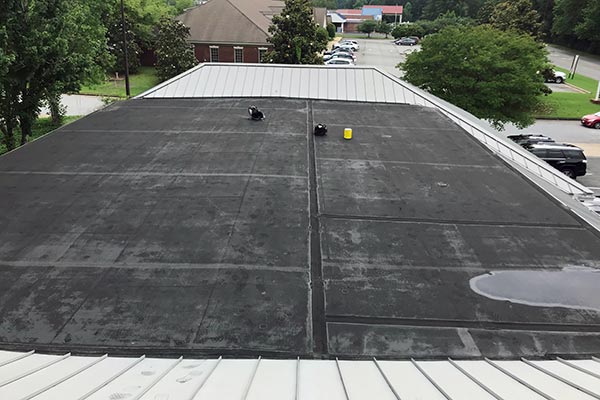
Comparing TPO and EPDM: Which Flat Roofing System Performs Better?
TPO roofing in Calgary offers a durable, energy-efficient solution for commercial and industrial properties. Famous for its powerful weather protection and affordability, TPO roofing is meant for Calgary’s variable climate.
At Angel’s Roofing, we take pride in our professional TPO installation, guaranteeing longevity with top-quality materials and skilled workmanship. Find out why we’re the roofing company that Calgary trusts.
Call us now for a complimentary quote.
TPO vs. EPDM Material Science
TPO (thermoplastic polyolefin) and EPDM (ethylene propylene diene monomer) are the top single-ply roofing materials when it comes to flat or low-slope roofs. Both have unique chemical compositions and performance attributes that suit various roofing requirements.
TPO is a blend of polypropylene and ethylene-propylene rubber. This formulation provides TPO with outstanding UV and heat resistance, causing it to reflect sunlight and lower cooling expenses.
EPDM, meanwhile, is a synthetic rubber made from ethylene and propylene and is famous for its elasticity and resistance to extreme weather. EPDM can expand up to 300% and return to its natural state, guaranteeing recovery in variable conditions.
TPO membranes are known for their elasticity and energy efficiency. They are stocked in reflective white, which helps reduce heat absorption, and keeps buildings cooler in hot climates.
EPDM membranes – usually black – absorb heat, which can be beneficial in colder climates. Both provide similar lifespans — typically over 25 years if appropriately installed. Some cheapo EPDM recipes can break down quicker, maybe just a decade.
Environmental Benefits of TPO and EPDM
- TPO: 100% recyclable, free from chlorine, and reflects solar heat, reducing energy consumption.
- EPDM: Requires less energy to manufacture, is low in maintenance, and minimizes waste due to its long lifespan.
Installation methods separate these materials even more. TPO membranes are heat-welded, creating strong, seamless bonds, whereas EPDM depends on adhesives or mechanical fasteners.
This makes installation easier for EPDM but may be less durable in the long run. Each material is strictly UV- and heat-resistant-tested, and both will perform for years when installed properly.
Performance in Extreme Climates
Calgary’s climate can be particularly challenging for roofing systems, given its extreme temperature variations, significant snowfall and hot summer sun. TPO roofing was designed with these conditions in mind.
TPO membranes are great performers in extreme cold and snow, standing up to cracking and warping which can potentially ruin other materials. Alberta’s extreme and volatile weather, with its hail and winds, tends to take a toll on roofs. TPO’s tear resistance and elasticity give extra protection against these forces, reducing the likelihood of punctures or structural failure.
Its resistance to being crushed under the weight of heavy snow makes it ideal for extended winters. One of TPO’s signature characteristics is its elevated Solar Reflective Index (SRI). This enables it to both reflect solar radiation and release heat, mitigating the heat island effect and decreasing cooling expenses during Calgary’s sweltering summers.
TPO has better reflectivity than EPDM roofings, so it’s more energy efficient in hot climates. UV and moisture are the two roof killers, and TPO is engineered to stand up to both. Its hardy composition — with a lifespan of 20 to 30 years — means it doesn’t easily become worn out with changing temperatures.
Routine care is still necessary to combat stress from Calgary’s extreme weather. Although EPDM roofing comes with robust hail and snow protection, TPO delivers an unbeatable mix of energy savings and weather resistance. Its resilience in Calgary’s extreme climate, paired with its economical benefits, makes it a reliable option for all home and business owners.
Installation Nuances and Challenges
Proper installation of TPO roofing systems is critical to ensuring long-term performance, especially in Calgary’s diverse weather conditions. Surface preparation is key. Both TPO and EPDM necessitate a clean, dry substrate to adhere to. Dust, moisture or debris can affect the strength of bond, making it more susceptible to leaking and early failure. This proves especially tough in the winter or during sudden downpours.
Making sure the seams are watertight is another TPO installation challenge. Different than EPDM that uses adhesives or seam tape, TPO membranes are usually heat welded. Although this produces a strong and leakproof seal, it requires skill and specialized machinery. Any unevenness in the weld can result in weak points — which makes TPO more labor-intensive.
EPDM, being easier to install, can still be problematic if the adhesive is misapplied or temperature changes cause the material to contract. The right adhesives and fasteners are important as well for both systems. TPO membranes, whether mechanically fastened, adhered or ballasted, have their own unique fasteners to hold the material in place and avoid damaging it.
On complicated roof architectures that have multiple penetrations, this gets more tricky. Likewise, EPDM installations rely greatly on compatible glues in order to not delaminate over time. Potential installation errors can significantly impact the longevity of TPO roofing systems:
- Insufficient surface cleaning, leading to adhesion failure.
- Poor seam welding, causing water infiltration.
- Incorrect fastener placement, resulting in membrane damage.
- Overstretching the material, increasing the risk of tears.
- Skipping proper flashing at roof edges and penetrations.
TPO installation is especially laborious on larger or layered roofs, where reach is restricted. Botched makes this process can reduce the roof’s life expectancy, which is why it’s best to leave it to the pros.
Long-Term Financial Implications
TPO roofing for Calgary homes may not seem like a big deal when you consider the long-term financial impact. TPO and EPDM systems each have their own benefits, and which one is more cost-effective depends on a number of factors, such as energy efficiency, maintenance, and durability.
- TPO vs. EPDM: A Cost Comparison. TPO roofing is energy efficient, reflecting sunlight and reducing cooling costs for large commercial buildings. The up-front investment is typically more than EPDM, but the energy savings can compensate for the upfront cost over the lifetime of the roof.
EPDM is generally cheaper to install and is better in terms of durability. Its rubber is weather-proof as well, so it’s a smart long-term saving. It doesn’t have TPO’s energy-reflective properties, and that could mean more utility costs in the long run.
- Energy efficiency of TPO membranes are especially efficient at conserving energy. By reflecting heat, they help keep buildings cooler in the warmer months and result in reduced air conditioning costs. Take, for example, a commercial property with a TPO roof can save thousands in utility bills a year over traditional roofing systems.
This makes TPO appealing across warmer regions or in Calgary’s summer months.
- EPDM roofs have low maintenance requirements, which means that their maintenance costs are on the lower side. Built to last, they’re able to handle extreme weather conditions, including Calgary snow and hail. With the right care, an EPDM roof can last 20-30 years, significantly cutting down on costly repairs or premature replacements.
- Weighing upfront expenses against future savings. Although TPO might be more expensive initially, its energy-efficient nature and durability frequently provide a superior value in the long run. EPDM, while cheaper upfront, won’t give you the same savings — better for people looking to make a smaller initial investment.
The Maintenance and Repair Reality
TPO roofing systems are durable and low-maintenance, a preferred choice for Calgary’s varied climate. Like any roof, they’re not 100% maintenance free. Routine inspections are required to catch little problems like seam failures or physical damage from debris, tools or foot traffic – 20-30% of TPO roofing failures.
Dealing with these issues ahead of time — say, re-welding seams — can stave off big, expensive repairs. TPO roofs demand seasonal care to fight unique environmental hurdles. During the summer, UV and thermal instability can cause blistering or cracking and will require prompt repairs.
In the winter, snow and ice need to be cleaned off to avoid any extra weight and damage. Spring and fall cleanings rid the roof of debris and get it ready for the changing temps. Yearly visits are highly advised to keep the roof on and running optimally.
With maintenance, TPO roofs can outrun their life expectancy by 10-15 years. For EPDM roofs, repairs are simple, even on older membranes. Rips can often be patched with seam tape, offering a much cheaper alternative to leaks and tears.
This ease of maintenance makes EPDM an attractive solution for homeowners in search of repairable solutions. Common maintenance tasks for both TPO and EPDM include:
- Inspecting for punctures, tears, or seam failures.
- Cleaning surfaces to remove dirt, mold, and debris.
- Checking for UV damage, especially during the summer months.
- Clearing snow and ice during winter to reduce strain.
- Addressing physical damage from tools or equipment promptly.
Periodic roof inspections are priceless in prolonging the life of TPO and EPDM systems. By addressing problems before they arise, homeowners and businesses alike can avoid costly expenses and keep their investments safeguarded for years to come.
Beyond the Membrane: System Synergy
TPO roofing systems, recognized for their robustness and resistance to the elements, depend on more than just the membrane to provide the best results. A properly integrated roofing system guarantees durability, performance, and value, particularly for Calgary’s volatile weather.
Insulation layers add an incredible amount of energy efficiency to TPO and EPDM systems. These layers, by minimizing heat transfer, allow the interiors to better hold their temperatures — which in turn reduces energy use.
For instance, high-performance polyisocyanurate insulation can be coupled with TPO membranes to provide enhanced thermal resistance, perfect for commercial buildings seeking to reduce operational expenses.
TPO and EPDM membranes’ compatibility with other components, like roof coatings and drains, bolsters system synergy. A reflective roof coating can increase solar reflectance, helping you to cut down on cooling costs in hot summers.
Sloping drainage keeps us dry and prevents leaks, lessening the burden on the membrane and other materials. For example, a 1/12 slope, prevalent in flat roofing, aligns perfectly with hardy TPO membranes that resist hail and elevated winds.
Roof design is key to wringing out every last bit of performance. A bad system can result in constant patching, and shoddy craft is the number one cause of breakages.
For example, poor flashing installation or membrane welding can cause leaks, which puts the whole system at risk. Collaborating with seasoned contractors guarantees that factors like insulation, drainage, and flashing all seamlessly come together to prevent these problems.
Working with experienced roofers is key. They have experience creating systems for Calgary’s particular weather. This guarantees that every element, from the membrane to the insulation, works together as a system, promoting lasting performance and durability.
Conclusion
TPO roofing is a smart option for Calgary’s one-of-a-kind climate. Its resilience, energy efficiency, and affordability make it a reliable choice for both residential and commercial properties. Angel’s Roofing has decades of expertise behind each of our jobs so your TPO roof gets the attention it deserves. With an experienced team that knows the rigors of extreme weather, we work with high-quality materials to provide lasting results.
Trust and quality motivate us. From installation to maintenance, we remain dedicated to your satisfaction. Let us help safeguard your property with a roof built to deliver.
Contact us today to book a consultation or get a complimentary quote. Let’s keep your next roofing project simple, dependable, and lasting.

